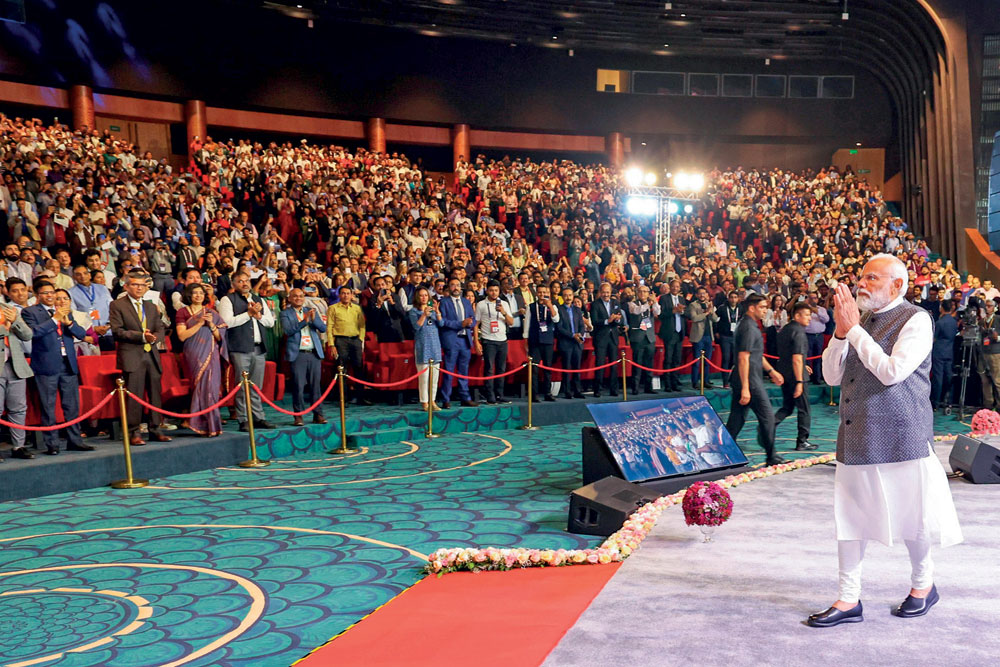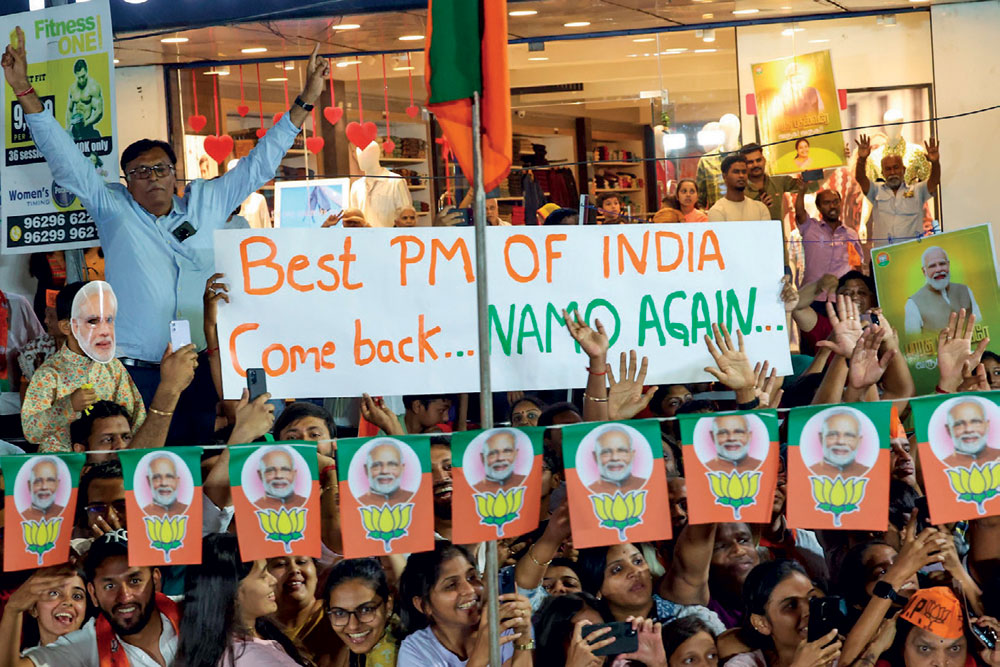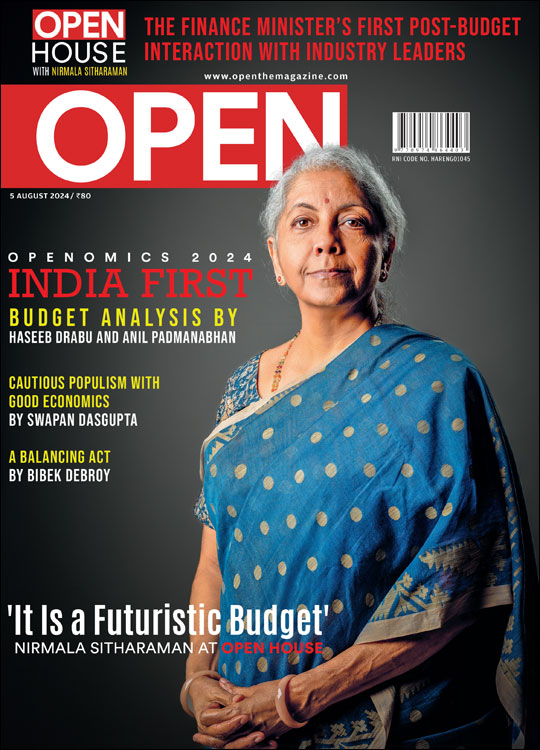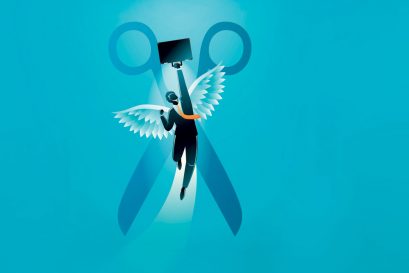
Prime Minister Narendra Modi addresses the ‘Startup Mahakumbh’ at Bharat Mandapam in New Delhi, March 20, 2024
Prime Minister Narendra Modi had a few succinct words of advice for a young audience at the Bharat Mandapam venue on March 19 attending the ‘Startup Mahakumbh, billed as an event for the next generation of innovators. “I asked some of you, have you finished the patent process? The answer is that this is ‘being done.’ I ask all of you to pay attention and do this [apply for patents]. Duniya mein itna kuch ho raha hai, pata nahin kaun kahan haath maar jaye (So much is happening around the world, there is no knowing who will bag the prize),” Modi said. Taking time out to offer advice on patents in an election season may seem an unconventional choice. But it was a deliberate one and marked one of Modi’s more consequential engagements amid typical campaign events like roadshows and rallies. Time was, he said, when it was felt only people with money could do business. The growth of the startup ecosystem changed all that and India has more than 110 unicorns and 1.25 lakh registered startups that employ more than 12 lakh people. He did acknowledge the electoral debate, wryly noting startups tend to be less successful in politics. “Some have to be launched and re-launched,” he said, the allusion drawing a titter. “The difference between them and you is that you are modern and progressive. If one idea does not work, you move to the next… Your vibe and energy is very palpable,” he added.
The prime minister’s theme was that startups mark new opportunities. Just as successful startups reflect the genius of their founders, he too had the ability to recognise the potential of the assembly. “I can recognise future entrepreneurs,” Modi said. Apart from a mild dig or two at the opposition, Modi stuck to outlining the promise of the startup system, for developing India as an economic power, the employment it generates, and how it changed the way business and commerce was done. There was no reference to the polarising discussions or the heated rhetoric over electoral bonds dominating headlines. The forward-looking agenda is, despite the loud and divisive aspects of electioneering, the focus of the Bharatiya Janata Party’s (BJP) campaign.
Campaign videos released by the party elaborate the rising India theme with the tagline “Bharat hua buland (India has become strong)” along with others that remind voters of schemes that have delivered houses, cooking gas, loans for small businesses, and benefits for farmers and students. There are videos that dwell on the promotion of artificial intelligence (AI) for innovators and global investors as well as the national quantum and semi-conductor missions. The success of the Unified Payments Interface (UPI) is evidence of the “democratisation” of technology. The ‘positive’ flavour of the campaign is hard to miss.
Political advertising that emphasises achievements of the incumbent government is hardly uncommon and it makes sense to concentrate on strong points. For the Modi government, it is a rebuttal of negative narratives around alleged acts of corruption and cronyism, democratic backsliding, economic hardship, and majoritarianism. These themes are visible on social media and are routinely circulated in WhatsApp groups. Almost every school/college alumni or residential association WhatsApp group has participants who unfailingly post such messages. In most cases, the posts have already been widely disseminated on social media. Incessant negative propaganda does have a chilling effect by inhibiting a fair and open discussion. The duelling over emotive identity issues no doubt provides BJP and its supporters an opportunity to sharpen their cultural agenda and fire up the voter base, but this is part of a bigger menu. The consecration of the Ram Mandir was a seminal event that deeply impacted the popular psyche but the key question is: Are you better off than you were five years ago? And what is your expectation of the future? This is the nub of the matter for voters individually and collectively. While arriving at an assessment, voters consider alternatives and all the promises and poll pledges on offer. It is not necessary that the more generous or profligate ones will succeed. In the Karnataka Assembly elections in May 2023, it was not just Congress’ populism that delivered. BJP paid the price for the Basavaraj Bommai government’s lacklustre performance. In another set of elections held not long after, Congress sought to replicate the Karnataka model but failed resoundingly. In Madhya Pradesh, Chhattisgarh and Rajasthan, Congress did not come across as a credible force despite a plethora of populist vows.

Odd as it may sound in a politically charged environment, BJP is looking to reap a ‘happiness dividend’ in an election where Modi has enlisted voters as active participants in his ‘400 par (400- plus seats)’ slogan. It is a negation of the bleak picture of ‘institution capture’ and a deteriorating democracy that Congress leader Rahul Gandhi dwells on at home and abroad. His warning on a visit to the US last year that the collapse of Indian democracy would impact the wider world was another way of berating global leaders for their reluctance to criticise Modi. This dark prognosis about India’s democracy and future trajectory does not generate popular traction. The reason being the lived experience of people does not square with the dire reading of India’s prospects. Irrespective of debates on equity and access, all major domestic and foreign reports about the Indian economy offer a bullish assessment. Despite caveats and quibbles, it is evident that extreme poverty has declined. All this did not have to happen. A record contraction of 23.9 per cent in the first quarter of 2020-21 was a massive blow to the Indian economy. A GDP growth rate of 5 per cent would have been considered healthy, let alone the current prediction of 2023-24 ending with close to 8 per cent growth. The optimism is not limited to the creamy layer alone. In fact, the older elites feel discomfited by the social levelling that accompanied the advent of the Modi government in 2014. A singular cause of frustration for the prime minister’s critics is the enduring support he receives from the socially and economically weaker sections. This is at odds with the view they subscribe to—of BJP being a party of upper-caste interests and hence intrinsically opposed to the backward classes and the poor. But those with little to fall back on make careful choices, as they have much at stake. This section of voters believes that Modi rather than the competition can deliver the goods. While individual benefits are always attractive, there is traction for the view that the size of the cake needs to grow and a rising tide does raise all boats. On the other hand, political uncertainty due to a weak leadership or unwieldy coalitions is bad for everyone.
Ahead of the 2014 General Election, realising the very real prospects of Modi becoming prime minister, a section of the commentariat had launched a determined attack on the ‘Gujarat model’, questioning its economic validity and calling it anti-minority. The narrative did not work as lakhs of migrants working in the state carried back to their hometowns and villages (in other states) accounts of Gujarat’s progress and its social stability. In the run-up to the 2019 General Election, allegations of graft in the Rafale fighter deal could not dent Modi’s image and finally the Supreme Court held that there had been no irregularities. After the results were out, the Congress leadership said all institutions, including the courts, the media, and the Election Commission of India (ECI), were compromised. The charge of institution capture—rather than an honest introspection—lies at the centre of the party’s account of its electoral dysfunction, and finds resonance in a dedicated echo-chamber. The problem for naysayers lies in the fact that their numbers have not increased much. Some have also switched sides. India’s social and religious faultlines are not new and will not heal overnight but a larger peace holds in the absence of communal violence and social unrest. Indians are travelling more and eating better. Bars, ahatas, and restaurants are thronging with crowds on weekends in cities and smaller towns as well. Malls and markets are filled with people and rising consumption supports the contention that private businesses are hiring and increasing capacity. If there are undetected signs of a society in distress and groaning under the weight of oppression, they are well-hidden.
THE PROMISE OF unprecedented development held out by Modi as his agenda for a third term is a bright picture of the future. Managing expectations after 10 years in office is never easy and most governments lose their sheen in their first term. There are inevitable weaknesses and voters who feel they are in the rain shadow of progress harbour reasons to feel discontented. But the reason this sentiment is not widespread is because many feel invested in Modi’s vision. They have experienced tangible benefits of the Union government’s interventions and are hesitant to trade a bird in hand for likely gains that sound alluring but could be illusory. The forward-leaning narrative in BJP’s election appeals is critical to the upbeat sentiment and this hinges on success stories like India’s digital infrastructure and ambitious initiatives to increase the capacity and participation of Indian industry in high-tech areas like space and microchips. The new normal of 8 per cent growth complements the confidence of markets where equities are touching new highs. The possibility that the coming years may mark a decisive break from an underachieving past has caught the imagination of voters as they prepare to elect the next government. In the last few months, Modi has accelerated his already hectic schedule, speaking at multiple venues every day, elaborating a message that is simple and consistent. His government has worked to reach necessities like electricity and water to every household, done more to curb corruption than any other administration, built a resilient economy, and secured India’s defence. In other words, the government has done nothing to be shown the door and everything to retain the nation’s trust.
The promise of unprecedented development held out by Modi as his agenda for a third term is a bright picture of the future. Most governments lose their sheen in their first term. But the reason this sentiment is not widespread is because many feel invested in Modi’s promises
Share this on 

The belief in a brighter tomorrow is not anchored in economic well-being alone. A robust cultural identity has found expression in public discourse and this marks a break from the past too. It plays out raucously when the new and assertive order clashes with older political idioms crafted by well-entrenched cultural commissars.
An acute sense of dispossession and a deeply held antipathy for any affirmation of nativist identities motivate the ancien régime. Not unexpectedly, the Left ecosystem has led the opposition to this cultural resurgence and its hand can be seen in the protests by Punjab’s farm unions, the violence that marked passage of the Citizenship Amendment Act (CAA) in 2019-20, the failed legal activism intended to prevent the Supreme Court from deciding the Ram Janmabhoomi dispute, and plots like the Bhima-Koregaon violence where the objective was to cause social unrest. One by one, despite political and legal setbacks, BJP has been able to win the ideological battles. The latest edition of the farm agitation has quickly run out of steam, a far cry from the prolonged blockade the farm unions had inflicted on the national capital in 2021. The consecration of the Ram Mandir marks the very religious and cultural effervescence that BJP’s adversaries have long tried to contain and deny. The political debate is likely to continue even if the legal case is settled but the joy and reverence of lakhs of devotees who have thronged the temple is a spontaneous and uninhibited celebration of faith. The sanctum sanctorum and the visage of the Ram Lalla idol leave devotees with a feeling of calm and wholeness that is at once an individual spiritual experience and a revitalisation of a collective memory. There is, in the cultural renewal, a sense of a wrong being righted. The contestation, however, cannot mask a new energy and a buoyant self-belief. The clearer and more organic definition of national identity that Modi offers strikes a chord with the masses. His use of idiomatic Hindi works well in the heartland but he has conveyed his message to voters in the Northeast and south as well. This is because his leadership comes across as authentic and rooted. Beneath the inevitable negativity and personal abuse that mark elections, an upbeat mood is discernible. BJP hopes to reap the political dividend but the happiness vote marks a social transition that goes beyond an election.


















More Columns
Art of Love Nandini Nair
Fruit of the Nation Madhavankutty Pillai
Ladakh: Magic Mountain Abhilasha Ojha